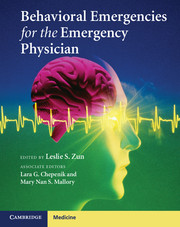13 results
Section 3. - Psychiatric illnesses
-
- Book:
- Behavioral Emergencies for the Emergency Physician
- Published online:
- 05 April 2013
- Print publication:
- 21 March 2013, pp 53-154
-
- Chapter
- Export citation
Behavioral Emergencies for the Emergency Physician - Half title page
-
- Book:
- Behavioral Emergencies for the Emergency Physician
- Published online:
- 05 April 2013
- Print publication:
- 21 March 2013, pp i-ii
-
- Chapter
- Export citation
Behavioral Emergencies for the Emergency Physician - Title page
-
-
- Book:
- Behavioral Emergencies for the Emergency Physician
- Published online:
- 05 April 2013
- Print publication:
- 21 March 2013, pp iii-iii
-
- Chapter
- Export citation

Behavioral Emergencies for the Emergency Physician
-
- Published online:
- 05 April 2013
- Print publication:
- 21 March 2013
Section 6. - Administration of psychiatric care
-
- Book:
- Behavioral Emergencies for the Emergency Physician
- Published online:
- 05 April 2013
- Print publication:
- 21 March 2013, pp 291-390
-
- Chapter
- Export citation
Preface
-
- Book:
- Behavioral Emergencies for the Emergency Physician
- Published online:
- 05 April 2013
- Print publication:
- 21 March 2013, pp xiii-xiv
-
- Chapter
- Export citation
Index
-
- Book:
- Behavioral Emergencies for the Emergency Physician
- Published online:
- 05 April 2013
- Print publication:
- 21 March 2013, pp 391-400
-
- Chapter
- Export citation
Section 1. - General considerations for psychiatric care in the emergency department
-
- Book:
- Behavioral Emergencies for the Emergency Physician
- Published online:
- 05 April 2013
- Print publication:
- 21 March 2013, pp 1-18
-
- Chapter
- Export citation
Section 2. - Evaluation of the psychiatric patient
-
- Book:
- Behavioral Emergencies for the Emergency Physician
- Published online:
- 05 April 2013
- Print publication:
- 21 March 2013, pp 19-52
-
- Chapter
- Export citation
Copyright page
-
- Book:
- Behavioral Emergencies for the Emergency Physician
- Published online:
- 05 April 2013
- Print publication:
- 21 March 2013, pp iv-iv
-
- Chapter
- Export citation
Section 5. - Special populations
-
- Book:
- Behavioral Emergencies for the Emergency Physician
- Published online:
- 05 April 2013
- Print publication:
- 21 March 2013, pp 211-290
-
- Chapter
- Export citation
Contents
-
- Book:
- Behavioral Emergencies for the Emergency Physician
- Published online:
- 05 April 2013
- Print publication:
- 21 March 2013, pp v-vii
-
- Chapter
- Export citation
Section 4. - Treatment of the psychiatric patient
-
- Book:
- Behavioral Emergencies for the Emergency Physician
- Published online:
- 05 April 2013
- Print publication:
- 21 March 2013, pp 155-210
-
- Chapter
- Export citation



